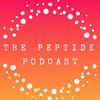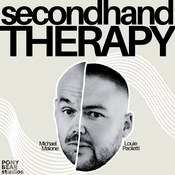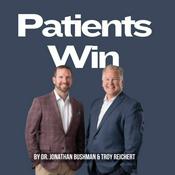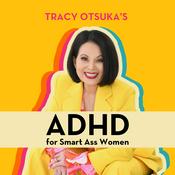170 episodes

NAD+, GHK-Cu, and the Push Patch
12/18/2025 | 10 mins.
Thanks for listening to The Peptide Podcast. Today, we're diving into the combined power of high-dose NAD+ and GHK-Cu. I'm genuinely excited about the technology behind a product called the Push Patch. It uses iontophoresis— which is a completely non-invasive technology that uses gentle electrical currents to push these ingredients deep into the skin and directly into circulation. But really, this episode isn't about the product itself—it's about what's inside it and how it's delivered. Read the Full Episode Transcript: https://pepties.com/nad-ghk-cu-and-the-push-patch/ Push Patch: https://PushPatch.com Podcast interview mentioned -Mind Pump 2672 - Peptides vs Bioregulators: The Future of Health Optimization w/ Nick Andrews Push Patch conversation starts at 43:50 https://youtu.be/9Kcg1GH9Vk0?si=aunac20OuowAwFsQ&t=2630 $5.99 Derma Roller to 10x the treatment: https://amzn.to/4oWWKUJ Dr. Nikki's Qualifications: https://bifat.life/about/ Related Links/Products Mentioned: Peptide Podcast Partners Page https://pepties.com/partners/ BioLongevity Labs (Purchase Peptides online) Use our link and enter COUPON CODE: PEPTIDEPODCAST at checkout to receive 15% off your total order https://go.biolongevitylabs.com/aff_c?offer_id=1&aff_id=1582&aff_sub=PEPTIDEPODCAST Momentous Supplements (we use Creatine, Vital Aminos, Whey Protein) https://crrnt.app/MOME/OqGQOxGA LMNT – More Salt, Not Less. https://elementallabs.refr.cc/default/u/johnjavit Thorne Supplements (we use Omega-3 with CoQ10, Red Yeast Rice, Zinc) https://get.aspr.app/SH1KvW Organifi Creatine and Shilajit Gummies http://rwrd.io/rlbkajm?c MitoZen (methylene blue for Cognitive Function, Anti-Aging, Mental Clarity) https://www.mitozen.com/ref/cnlwiztypt/ For skin and hair health (Copper Tripeptide-1) Visit Luminose by Entera for an exclusive offer for Peptide Podcast listeners! ** Promo code PEPTIDEPODCAST at checkout for 10% off an order or 10% off the first month of a subscribe-and-save. ** https://www.enteraskincare.com/?rfsn=8906839.f93c72 NAD+ Push Patch: https://www.pushpatch.com/ 📚 Free Information: A Comprehensive Guide to the Top 27 Peptide Therapies https://pepties.com/a-comprehensive-guide-to-the-top-27-peptide-therapies-how-they-work-benefits-and-side-effects/ The Ultimate Peptide Therapy Guide https://pepties.com/the-ultimate-peptide-therapy-guide/ Peptide Injections: How Do You Inject Yourself With Peptides? https://pepties.com/guide-to-injecting-peptides/ Top Episodes: Injectable BPC-157 vs Oral BPC-157 https://pepties.com/injectable-bpc-157-vs-oral-bpc-157/ NAD+ https://pepties.com/nad/ FAQs About Tirzepatide https://pepties.com/faqs-about-tirzepatide/

GLP-1 Therapies Strategies: Weekly, Micro-Dose, and Maintenance
12/11/2025 | 9 mins.
Thanks for listening to The Peptide Podcast. Today, we're diving into GLP‑1 therapies, including dual GIP/GLP‑1 agonists and the emerging triple agonists, and talking about how these peptides are typically dosed, what people are experimenting with, and what the research — or real-world experience — tells us so far. Read the Full Episode Transcript: https://pepties.com/glp-1-therapies-strategies-weekly-micro-dose-and-maintenance/ Dr. Nikki's Qualifications: https://bifat.life/about/ Related Links/Products Mentioned: Peptide Podcast Partners Page https://pepties.com/partners/ BioLongevity Labs (Purchase Peptides online) Use our link and enter COUPON CODE: PEPTIDEPODCAST at checkout to receive 15% off your total order https://go.biolongevitylabs.com/aff_c?offer_id=1&aff_id=1582&aff_sub=PEPTIDEPODCAST Momentous Supplements (we use Creatine, Vital Aminos, Whey Protein) https://crrnt.app/MOME/OqGQOxGA LMNT – More Salt, Not Less. https://elementallabs.refr.cc/default/u/johnjavit Thorne Supplements (we use Omega-3 with CoQ10, Red Yeast Rice, Zinc) https://get.aspr.app/SH1KvW Organifi Creatine and Shilajit Gummies http://rwrd.io/rlbkajm?c MitoZen (methylene blue for Cognitive Function, Anti-Aging, Mental Clarity) https://www.mitozen.com/ref/cnlwiztypt/ For skin and hair health (Copper Tripeptide-1) Visit Luminose by Entera for an exclusive offer for Peptide Podcast listeners! ** Promo code PEPTIDEPODCAST at checkout for 10% off an order or 10% off the first month of a subscribe-and-save. ** https://www.enteraskincare.com/?rfsn=8906839.f93c72 📚 Free Information: A Comprehensive Guide to the Top 27 Peptide Therapies https://pepties.com/a-comprehensive-guide-to-the-top-27-peptide-therapies-how-they-work-benefits-and-side-effects/ The Ultimate Peptide Therapy Guide https://pepties.com/the-ultimate-peptide-therapy-guide/ Peptide Injections: How Do You Inject Yourself With Peptides? https://pepties.com/guide-to-injecting-peptides/ Top Episodes: Injectable BPC-157 vs Oral BPC-157 https://pepties.com/injectable-bpc-157-vs-oral-bpc-157/ NAD+ https://pepties.com/nad/ FAQs About Tirzepatide https://pepties.com/faqs-about-tirzepatide/

A New Era for Menopause Care — What the Removal of the Black‑Box Warning Means
12/04/2025 | 5 mins.
Thanks for listening to The Peptide Podcast. Today, we're diving into some exciting news in menopause care. The FDA and the Department of Health and Human Services just announced a major update that could shift how hormone therapy is prescribed, understood, and used by people going through menopause now or in the future. Read the Full Episode Transcript: https://pepties.com/a-new-era-for-menopause-care-what-the-removal-of-the-blackbox-warning-means/ Dr. Nikki's Qualifications: https://bifat.life/about/ Related Links/Products Mentioned: Peptide Podcast Partners Page https://pepties.com/partners/ BioLongevity Labs (Purchase Peptides online) Use our link and enter COUPON CODE: PEPTIDEPODCAST at checkout to receive 15% off your total order https://go.biolongevitylabs.com/aff_c?offer_id=1&aff_id=1582&aff_sub=PEPTIDEPODCAST Momentous Supplements (we use Creatine, Vital Aminos, Whey Protein) https://crrnt.app/MOME/OqGQOxGA LMNT – More Salt, Not Less. https://elementallabs.refr.cc/default/u/johnjavit Thorne Supplements (we use Omega-3 with CoQ10, Red Yeast Rice, Zinc) https://get.aspr.app/SH1KvW Organifi Creatine and Shilajit Gummies http://rwrd.io/rlbkajm?c MitoZen (methylene blue for Cognitive Function, Anti-Aging, Mental Clarity) https://www.mitozen.com/ref/cnlwiztypt/ For skin and hair health (Copper Tripeptide-1) Visit Luminose by Entera for an exclusive offer for Peptide Podcast listeners! ** Promo code PEPTIDEPODCAST at checkout for 10% off an order or 10% off the first month of a subscribe-and-save. ** https://www.enteraskincare.com/?rfsn=8906839.f93c72 📚 Free Information: A Comprehensive Guide to the Top 27 Peptide Therapies https://pepties.com/a-comprehensive-guide-to-the-top-27-peptide-therapies-how-they-work-benefits-and-side-effects/ The Ultimate Peptide Therapy Guide https://pepties.com/the-ultimate-peptide-therapy-guide/ Peptide Injections: How Do You Inject Yourself With Peptides? https://pepties.com/guide-to-injecting-peptides/ Top Episodes: Injectable BPC-157 vs Oral BPC-157 https://pepties.com/injectable-bpc-157-vs-oral-bpc-157/ NAD+ https://pepties.com/nad/ FAQs About Tirzepatide https://pepties.com/faqs-about-tirzepatide/

Creatine Explained
11/27/2025 | 13 mins.
Thanks for listening to The Peptide Podcast. Today, we're diving into one of the most talked-about supplements out there: creatine. You've probably heard the basics — it can help you lift heavier and get stronger. But creatine isn't just a gym supplement. It's also being studied for brain health, recovery after stroke, and even certain muscle disorders. In this episode, we'll break down what creatine actually is, where it comes from — in food and in supplements — how it works in your body, the real benefits, the real risks, and how to dose it safely and effectively. Read the Full Episode Transcript: https://pepties.com/creatine-explained/ Dr. Nikki's Qualifications: https://bifat.life/about/ Related Links/Products Mentioned: Peptide Podcast Partners Page https://pepties.com/partners/ BioLongevity Labs (Purchase Peptides online) Use our link and enter COUPON CODE: PEPTIDEPODCAST at checkout to receive 15% off your total order https://go.biolongevitylabs.com/aff_c?offer_id=1&aff_id=1582&aff_sub=PEPTIDEPODCAST Momentous Supplements (we use Creatine, Vital Aminos, Whey Protein) https://crrnt.app/MOME/OqGQOxGA LMNT – More Salt, Not Less. https://elementallabs.refr.cc/default/u/johnjavit Thorne Supplements (we use Omega-3 with CoQ10, Red Yeast Rice, Zinc) https://get.aspr.app/SH1KvW Organifi Creatine and Shilajit Gummies http://rwrd.io/rlbkajm?c MitoZen (methylene blue for Cognitive Function, Anti-Aging, Mental Clarity) https://www.mitozen.com/ref/cnlwiztypt/ For skin and hair health (Copper Tripeptide-1) Visit Luminose by Entera for an exclusive offer for Peptide Podcast listeners! ** Promo code PEPTIDEPODCAST at checkout for 10% off an order or 10% off the first month of a subscribe-and-save. ** https://www.enteraskincare.com/?rfsn=8906839.f93c72 📚 Free Information: A Comprehensive Guide to the Top 27 Peptide Therapies https://pepties.com/a-comprehensive-guide-to-the-top-27-peptide-therapies-how-they-work-benefits-and-side-effects/ The Ultimate Peptide Therapy Guide https://pepties.com/the-ultimate-peptide-therapy-guide/ Peptide Injections: How Do You Inject Yourself With Peptides? https://pepties.com/guide-to-injecting-peptides/ Top Episodes: Injectable BPC-157 vs Oral BPC-157 https://pepties.com/injectable-bpc-157-vs-oral-bpc-157/ NAD+ https://pepties.com/nad/ FAQs About Tirzepatide https://pepties.com/faqs-about-tirzepatide/

Cialis and Anti-Aging
11/20/2025 | 8 mins.
Thanks for listening to The Peptide Podcast. Today I want to talk about the use of Cialis (tadalafil), beyond erectile dysfunction, because research is showing its potential as an anti-aging therapy. And while, Cialis is not a peptide, it sometimes comes up in the same conversations because of its role in anti-aging. We'll break down how Cialis works for erectile dysfunction in addition to its effects on the heart, brain health, muscle performance, inflammation, and even surprising benefits for women. By the end, you'll have a clearer picture of how Cialis might fit into a long-term anti-aging strategy. Read the Full Episode Transcript: https://pepties.com/cialis-and-anti-aging/ Dr. Nikki's Qualifications: https://bifat.life/about/ Related Links/Products Mentioned: Peptide Podcast Partners Page https://pepties.com/partners/ BioLongevity Labs (Purchase Peptides online) Use our link and enter COUPON CODE: PEPTIDEPODCAST at checkout to receive 15% off your total order https://go.biolongevitylabs.com/aff_c?offer_id=1&aff_id=1582&aff_sub=PEPTIDEPODCAST Momentous Supplements (we use Creatine, Vital Aminos, Whey Protein) https://crrnt.app/MOME/OqGQOxGA LMNT – More Salt, Not Less. https://elementallabs.refr.cc/default/u/johnjavit Thorne Supplements (we use Omega-3 with CoQ10, Red Yeast Rice, Zinc) https://get.aspr.app/SH1KvW Organifi Creatine and Shilajit Gummies http://rwrd.io/rlbkajm?c MitoZen (methylene blue for Cognitive Function, Anti-Aging, Mental Clarity) https://www.mitozen.com/ref/cnlwiztypt/ For skin and hair health (Copper Tripeptide-1) Visit Luminose by Entera for an exclusive offer for Peptide Podcast listeners! ** Promo code PEPTIDEPODCAST at checkout for 10% off an order or 10% off the first month of a subscribe-and-save. ** https://www.enteraskincare.com/?rfsn=8906839.f93c72 📚 Free Information: A Comprehensive Guide to the Top 27 Peptide Therapies https://pepties.com/a-comprehensive-guide-to-the-top-27-peptide-therapies-how-they-work-benefits-and-side-effects/ The Ultimate Peptide Therapy Guide https://pepties.com/the-ultimate-peptide-therapy-guide/ Peptide Injections: How Do You Inject Yourself With Peptides? https://pepties.com/guide-to-injecting-peptides/ Top Episodes: Injectable BPC-157 vs Oral BPC-157 https://pepties.com/injectable-bpc-157-vs-oral-bpc-157/ NAD+ https://pepties.com/nad/ FAQs About Tirzepatide https://pepties.com/faqs-about-tirzepatide/
More Health & Wellness podcasts
Trending Health & Wellness podcasts
About The Peptide Podcast
Listen to The Peptide Podcast, Passion Struck with John R. Miles and many other podcasts from around the world with the radio.net app

Get the free radio.net app
- Stations and podcasts to bookmark
- Stream via Wi-Fi or Bluetooth
- Supports Carplay & Android Auto
- Many other app features
Get the free radio.net app
- Stations and podcasts to bookmark
- Stream via Wi-Fi or Bluetooth
- Supports Carplay & Android Auto
- Many other app features


The Peptide Podcast
download the app,
start listening.







































